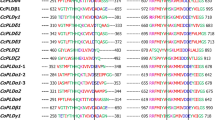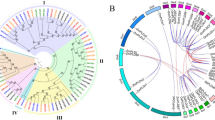Abstract
Phospholipase D hydrolyzes phospholipids into phophatidic acid and choline, and plays important roles in growth, development, and stress response. Genome-wide identification for the PLD gene family has been made in several model species. In maize, only a few literatures are available for cloning and function elucidation of several individual members of the PLD gene family. In this study, thirteen members of the ZmPLD gene family were identified from the maize genome by homologous alignment and conserved domain analysis. Bioinformatics analysis displayed abundant diversification of the gene structure, and differential expression patterns in different development stages and organs among these members, as well as numerous cis-acting elements during their promoter sequences. The expression of these members in seedling shoot and root under abiotic stress and hormone induction was detected by quantitative reverse transcription PCR. The result showed significant differentiation of their relative expression levels in response to stress of drought, high salt, and low temperature, and to induction of abscisic acid, methyl jasmonate, and gibberellic acid. All these results suggest that structure and function of the ZmPLD gene family are diversified among the members, as well as different from the genetic model species such as Arabidopsis and rice. Laboratory experiment should be conducted to elucidate their detail functions one by one.







Similar content being viewed by others
References
Brauer D, Nungesser E, Maxwell RJ, Schubert C, Tu SL (1990) Evidence for and subcellular localization of a ca-stimulated phospholipase D from maize roots. Plant Physiol 92:672–678
Camoni L, di Lucente C, Pallucca R, Visconti S, Aducci P (2012) Binding of phosphatidic acid to 14-3-3 proteins hampers their ability to activate the plant plasma membrane H+-ATPase. IUBMB Life 64:710–716
Cenzano A, Cantoro R, Racagni G, de Los Santos-BrionesC, Hernandez-Sotomayor T, Abdala G (2008) Phospholipid and phospholipase changes by jasmonic acid during stolon to tuber transition of potato. Plant Growth Regul 56:307–316
Dhonukshe P, Laxult AM, Goedhart J, Gadella TWJ, Munnik T (2003) Phospholipase D activation correlates with microtubule remorganization in living plant cells. Plant Cell 15:2666–2679
Elias M, Potocky M, Cvrckova F, Zarsky V (2002) Molecular diversity of phospholipase D in angiosperms. BMC Genom 3:2
Finn RD, Bateman A, Clements J, Coggill P, Eberhardt RY, Eddy SR, Heger A, Hetherington K, Holm L, Mistry J, Sonnhammer RLL, Tate J, Punta M (2014) PFAM: the protein families database. Nucleic Acid Res 42:D222–D230
Guo AY, Zhu QH, Chen X, Luo JC (2007) GSDS: a gene structure display server. Yi Chuan 29:1023–1026
Hoagland DR, Arnon DI (1950) The water-culture method for growing plants without soil. Circ Calif Agric Exp Stn 347:32
Hong Y, Devaiah SP, Bahn SC, Thamasandra BN, Li M, Welti R, Wang X (2009) Phospholipase D and phosphatidic acid enhance Arabidopsis nitrogen signaling and growth. Plant J 58:376–387
Hong Y, Zhang W, Wang X (2010) Phospholipase D and phosphatidic acid signalling in plant response to drought and salinity. Plant Cell Environ 33:627–635
Hu R, Fan C, Li H, Zhang O, Fu YF (2009) Valuation of putative reference genes for gene expression normalization in soybean by quantitative real-time RT-PCR. BMC Mol Biol 10:93
Jenkins GM, Frohman MA (2005) Phospholipase D: a lipid centric review. Cell Mol Life Sci 62:2305–2316
Kolesnikov YS, Nokhrina KP, Kretynin SV, Volotovski ID, Martinec J, Romanov GA, Kravets VS (2012) Molecular structure of phospholipase D and regulatory mechanisms of its activity in plant and animal cells. Biochemistry 77:1–14
Konturs’ka OO, Palladina TO (2008) Phospholipase D activity in maize seedling roots under salt stress and presowing treatment by preparations of adaptogenic action. Ukr Biokhim Zh 80:141–146
Lein W, Saalbach G (2001) Cloning and direct G-protein regulation of phospholipase D from tobacco. Biochem Biophys Acta 1530:172–183
Lescot M, Dhais P, Thijs G, Marchal K, Moreau Y, van de Peer Y, Rouz P, Rombauts S (2002) PlantCARE, a database of plant cis-acting regulatory elements and a portal to tools for in silico analysis of promoter sequences. Nucleic Acid Res 30:325–327
Li G, Xue HW (2007) Arabidopsis PLDζ2 regulates vesicle trafficking and is required for auxin response. Plant Cell 19:281–295
Li W, Li M, Zhang W, Welti R, Wang X (2004) The plasma membrane-bound phospholipase Ddelta enhances freezing tolerance in Arabidopsis thaliana. Nat Biotechnol 22:427–433
Li M, Welti R, Wang X (2006) Quantitative profiling of Arabidopsis polar glycerolipids in response to phosphorus starvation: role of phospholipase Df1 and f2 in phosphatidylcholine hydrolysis and digalactosyldiacylglycerol accumulation in phosphorus-starved plants. Plant Physiol 142:750–761
Li G, Lin F, Xue HW (2007) Genome-wide analysis of the phospholipase D family in Oryza sativa and functional characterization of PLDβ1 in seed germination. Cell Res 17:881–894
Liu Q, Zhang C, Yang Y, Hu X (2010) Genome-wide and molecular evolution analyses of the phospholipase D gene family in poplar and grape. BMC Plant Biol 10:107–113
Livak KJ, Schmittgen TD (2001) Analysis of relative gene expression data using real-time quantitative PCR and the 2−∆∆CT method. Methods 25:402–408
Lovdal T, Lillo C (2009) Reference gene selection for quantitative real-time PCR normalization in tomato subjected to nitrogen, cold, and light stress. Annal Biochem 387:238–242
Michel BE, Kaufmann MR (1973) The osmotic potential of polyethylene glycol 6000. Plant Physiol 51:914–916
Ohashi Y, Oka A, Rodrigues-Pousada R, Possenti M, Ruberti I, Morelli G, Aoyama T (2003) Modulation of phospholipid signaling by GLABRA2 in root-hair pattern formation. Science 300:1427–1430
Qin C, Wang X (2002) The Arabidopsis phospholipase D family characterization of a calcium-independent and phosphatidylcholine-selective PLDζ1 with distinct regulatory domains. Plant Physiol 128:1057–1068
Schnable PS, Ware D, Fulton RS et al (2009) The B73 maize genome: complexity, diversity, and dynamics. Science 326:1112–1115
Tong Z, Gao Z, Wang F, Zhou J, Zhang Z (2009) Selection of reliable reference genes for gene expression studies in peach using real-time PCR. BMC Mol Biol 10:71
Ueki J, Morioka S, Komari T, Kumashiro T (1995) Purification and characterization of phospholipase D (PLD) from rice (Oryza sativa L.) and cloning of cDNA for PLD from rice and maize (Zea mays L.). Plant Cell Physiol 36:903–914
van Leeuwen W, Okresz L, Bogre L, Munnik T (2004) Learning the lipid language of plant signaling. Trends Plant Sci 9:378–384
Wang X (2005) Regulatory functions of phospholipase D and phosphatidic acid in plant growth, development, and stress responses. Plant Physiol 139:566–573
Wang C, Zien CA, Afitlhile M, Welti R, Hildebrand DF, Wang X (2000) Involvement of phospholipase D in wound-induced accumulation of jasmonic acid in Arabidopsis. Plant Cell 12:2237–2246
Wang J, Ding B, Guo Y, Li M, Chen S, Huang G, Xie X (2014) Overexpression of a wheat phospholipase D gene, TaPLDα, enhances tolerance to drought and osmotic stress in Arabidopsis thaliana. Planta 240:103–115
Whitaker BD, Smith DL, Green KC (2001) Cloning, characterization and functional expression of a phospholipase D alpha cDNA from tomato fruit. Physiol Plant 112:87–94
Yamaguchi T, Kuroda M, Yamakawa H, Ashizawa T, Hirayae K, Kurimoto L, Shinya T, Shibuya N (2009) Suppression of a phospholipase D gene, OsPLDb1, activates defense responses and increases disease resistance in rice. Plant Physiol 150:308–319
Yamaryo Y, Dubots E, Albrieux C, Baldan B, Block MA (2008) Phosphate availability affects the tonoplast localization of PLDζ2, an Arabidopsis thaliana phospholipase D. FEBS Lett 582:685–690
Yang N, Ding F-X, Wu G-F, Wang C-L, Ding L, An L-Z (2015) Phospholipase Dα from Chorispora bungeana: cloning and partial functional characterization. Plant Growth Regul 75:511–520
Zhang W, Wang C, Qin C, Wood T, Olafsdottir G, Welti R, Wang X (2003) The oleate-stimulated phospholipase D, PLDd, and phosphatidic acid decrease H2O2-induced cell death in Arabidopsis. Plant Cell 15:2285–2295
Zhao J, Zhou D, Zhang Q, Zhang W (2012) Genomic analysis of phospholipase D family and characterization of GmPLDas in soybean (Glycine max). J Plant Res 125:569–578
Zhou S, Wei F, Nguyen J, Bechner M, Potamousis K, Goldstein S, Pape L, Mehan MR, Churas C, Pasternak S, Forrest DK, Wise R, Ware D, Wing RA, Waterman MS, Livny M, Schwartz DC (2009a) A single molecule scaffold for the maize genome. PLoS Genet 5:e1000711
Zhou X, Zhen S, Douglas Sammons R, Peng Y, Tranel PJ, Stewart CN Jr, Yuan JS (2009b) Novel software package for cross-platform transcriptome analysis (CPTRA). BMC Bioinform 10(Suppl 11):S16
Acknowledgments
This work was supported by the National Key Science and Technology Special Project (2014ZX08003-004), and the National Natural Science Foundation of China (31071433). The authors thank the technical support from Key Laboratory of Biology and Genetic Improvement of Maize in Southwest Region, and appreciate the anonymous reviewers for their critical comments and modification suggestions, and Mr. Aleix Martinez at University of California Berkeley for his help in improving the English writing.
Author information
Authors and Affiliations
Corresponding authors
Additional information
Lei Chen and Bo Cao have contributed equally.
Electronic supplementary material
Below is the link to the electronic supplementary material.

10725_2016_197_MOESM1_ESM.jpg
Fig. S1: Flowchart of bioinformatics analysis of the ZmPLD gene family. The amino acid sequences of the twelve and seventeen members of the PLD families in Arabidopsis and rice were used as queries to search for homologous sequences against Maize GDB database. After elimination of redundant sequences by using a custom Perl program, the conserved domains of the PLD family were identified from the homologous sequences by using the online tools SMART and PFAM. The objects were recognized as the members of the ZmPLD gene family, and used to construct phylogenetic tree with the members of the AtPLD and the OsPLD gene families by using MEGA5.1. The gene structure was analyzed by using the online software GSDS. The cis-acting regulatory elements were searched from the 1500 bp sequences upstream of the start codon ATG of these thirteen members of the ZmPLD gene family by using PlantCARE software. The expression patterns of these thirteen members in different development stages and different organs were analyzed by using transcriptome analysis software MEV4.0 against Maize GDB database and qteller database. (JPG 80 KB)
Rights and permissions
About this article
Cite this article
Chen, L., Cao, B., Han, N. et al. Phospholipase D family and its expression in response to abiotic stress in maize. Plant Growth Regul 81, 197–207 (2017). https://doi.org/10.1007/s10725-016-0197-4
Received:
Accepted:
Published:
Issue Date:
DOI: https://doi.org/10.1007/s10725-016-0197-4




